
Solid Support Oligosaccharide Synthesis
.pdf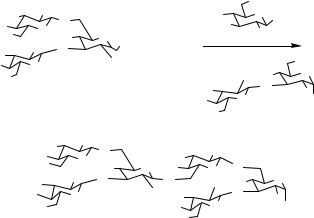
220 CARBOHYDRATE LIBRARIES IN SOLUTION
glycosyl halide with AgOTf in the presence of a thiophenyl glycoside acceptor. Addition of NIS activates the resulting thiophenyl glycoside disaccharide for reaction with the new acceptor that is added subsequently. While thiophenyl glycosides are almost exclusively used as the second donor, Takahashi and coworkers have investigated trichloroacetimidates or glycosyl fluorides as substitutes for glycosyl bromides as the first donor. Yields for different trisaccharide products varied within 40–85%. Takahashi extended these studies to larger targets using more complex building blocks.11 The hexasaccharide product shown in Scheme 11.6 is furnished in a one-pot strategy using a trisaccharide and a trichloroacetimidate activated with TMSOTf in the presence of a thiophenylglycoside. Subsequent addition of the suitably protected disaccharide and NIS/TfOH as an activator yields the desired product in 50% yield.
|
|
|
|
|
1) TMSOTf and |
|
|
|
|
|
|
|
|
|
OH |
RO |
OR |
|
|
|
OAc |
|
O |
|
O |
|
|
|
SPh |
||
RO |
O |
|
|
OAc |
|
|
|
RO |
BnO |
O |
|
|
|
OAc |
|
|
RO |
OC(NH)CCl3 |
|
|
|
||
RO |
O |
|
|
|
|
||
|
|
BzO |
|
2) NIS/TfOH and |
OH |
||
RO |
O |
|
|
||||
|
|
|
|
O |
|||
|
|
|
|
|
|
||
|
|
|
|
|
|
RO |
|
RO |
|
|
|
|
|
OAc |
|
|
|
|
|
|
RO |
|
O |
|
|
|
|
|
|
RO |
|
|
|
|
|
|
|
|
|
|
|
|
|
|
RO |
O |
OMe |
|
|
|
|
|
RO |
|
|
|
RO |
OR |
|
|
|
|
|
|
|
O |
|
OAc |
|
|
|
|
RO |
|
OAc |
|
|
||
|
O |
|
|
|
|
||
|
RO |
|
|
O |
|
||
|
|
RO |
BnO |
O OAc |
O |
O |
|
|
RO |
O |
O |
RO |
OAc |
||
|
|
|
|
|
|||
|
RO |
O |
|
BzO |
|
O |
|
|
|
|
OR |
|
|
RO |
|
|
|
|
|
OR |
O |
|
|
|
OR |
|
|
|
OMe |
||
RO (50% recovered)
Scheme 11.6 Hexasaccharide production in a one-pot strategy.
11.2.6 Chenault and Varied Glycoside Donors
Building on the observations of Kahne and Takahashi, Chenault and Castro relied on the selective activation of an isopropenyl glycoside donor with TMSOTf, followed by subsequent activation of a second n-pentenyl glycoside with NIS/TESOTf.12 This one-pot glycosylation offers proof of the concept that Fraser-Reid’s glycosides can be incorporated into one-pot syntheses. (See Scheme 11.7.)
11.2.7 Ley and a Universal Approach
Ley and coworkers13–18 are responsible for setting much of the stage on which our work is played. Showcased by the synthesis of the heptasaccharide shown in Scheme
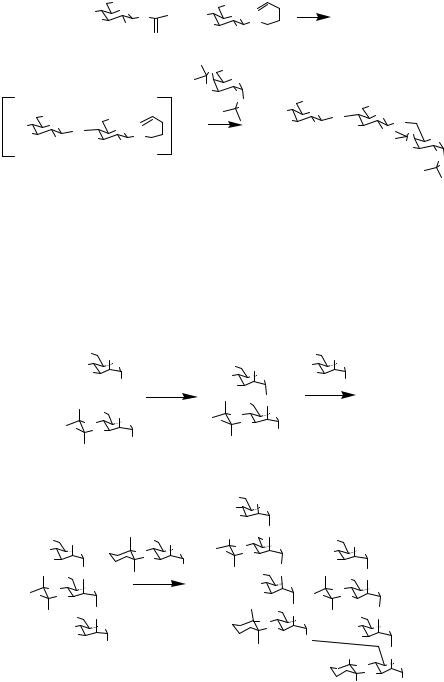
|
|
|
|
|
|
11.2 AN ABBREVIATED HISTORY |
221 |
||||
|
|
|
OPiv |
|
|
OBn |
|
TMSOTf |
|
|
|
|
|
PivO |
O |
|
|
|
|
|
|
||
|
|
+ |
|
O |
|
|
|
|
|||
|
|
O |
HO |
|
|
|
|
|
|||
|
|
PivO |
O |
|
|
|
|
|
|||
|
|
|
OPiv |
|
BnO |
OBn |
|
|
|
|
|
|
|
|
|
|
|
|
|
|
|
|
|
|
|
|
|
|
O |
OH |
|
|
|
|
|
|
|
|
|
|
|
O |
|
|
|
|
|
|
|
|
|
|
O |
O |
|
|
|
|
|
|
|
|
|
|
|
|
OPiv |
|
|
|
|
|
|
|
|
|
|
O |
|
OBn |
|
|
|
|
|
|
|
|
|
PivO |
O |
|
|
||
|
OPiv |
|
|
|
|
|
O |
|
|
||
|
|
OBn |
|
|
|
O |
|
|
|||
|
O |
|
|
|
|
PivO |
|
O |
|
||
PivO |
|
O |
|
|
|
OPiv BnO |
|
|
|||
|
O |
|
|
|
|
BnO |
O |
|
|||
PivO |
|
O |
|
|
|
|
|
|
O |
||
|
OPiv |
BnO |
|
NIS/TESOTf |
|
|
|
|
|||
|
OBn |
|
|
(25% recovered) |
O |
|
|||||
|
|
|
|
|
|
|
O |
||||
|
|
|
|
|
|
|
|
|
|
|
|
|
|
|
|
|
|
|
|
|
|
|
O |
Scheme 11.7 A one-pot glycosylation reaction.
11.8, Ley and coworkers have (1) explored the use of cyclic 3,4-diketals to influence the rate of oxionium ion formation (common activator, common donor), (2) utilized thiophenyl and selenophenyl donors to achieve targets (different donors, common activator), and (3) adopted most encompassing approaches to one-pot syntheses.
|
|
BnO |
OBn |
|
|
|
|
|
|
|
|
BnO OH |
|
|
|||||
|
|
BnO |
|
O |
|
|
|
BnO |
|
OBn |
|
BnO |
|
O |
|
|
|||
|
|
BnO |
|
|
AgOTF (4.8eq) |
BnO |
|
O |
|
|
BnO |
|
|
|
|
||||
|
|
|
|
|
|
|
|
|
|
|
|
|
|
|
|
||||
|
|
|
|
+ |
F |
Cp2HfCl2 (2.4eq) |
BnO |
|
|
|
|
|
|
|
SePh |
|
|||
|
|
MeO |
RO |
|
|
|
|
MeO BzO O |
|
|
AgOTF (4.2eq) |
|
|||||||
|
|
OH |
|
|
|
|
|
|
O |
|
|
||||||||
|
|
|
|
|
|
|
O |
O |
|
Cp2HfCl2 (2.1eq) |
|
||||||||
|
|
|
|
O O |
O |
|
|
|
|
|
|
||||||||
|
|
|
|
|
|
|
|
|
|
|
F |
|
|
|
|
|
|
|
|
|
|
|
|
|
F |
|
|
|
MeO |
|
|
|
|
|
|
|
|
|
|
|
|
MeO |
|
|
|
|
|
|
|
|
|
|
|
|
|
|
|||
|
|
R=TBDPS |
|
|
|
|
|
|
|
|
|
|
|
|
|
|
|||
|
|
|
|
|
|
|
|
|
|
|
|
|
|
|
|
|
|
||
|
|
|
|
|
|
|
|
|
BnO |
|
OBn |
|
|
|
|
|
|
|
|
|
|
|
|
|
|
|
|
|
BnO |
|
O |
|
|
|
|
|
|
|
|
|
|
|
|
|
|
|
|
|
BnO |
|
|
|
|
|
|
|
|
|
|
BnO |
|
OBn |
|
MeO |
HO |
OH |
MeO |
|
OBz O |
|
|
BnO |
|
OBn |
|
||||
|
|
|
O O |
O |
|
|
|
|
|||||||||||
BnO |
|
|
O |
|
|
O |
|
O |
|
|
|
BnO |
|
|
O |
|
|||
|
|
|
|
O |
|
|
|
|
|
|
|
||||||||
BnO |
|
|
|
|
|
|
|
|
|
|
|
|
|
BnO |
|
|
|
|
|
MeO BzO |
O |
|
MeO |
|
|
SePh |
MeO |
|
BnO |
O |
|
|
MeO BzO |
O |
|
||||
|
|
|
|
|
|
O |
|
|
|||||||||||
|
O |
|
|
O |
|
|
|
|
|
|
BnO |
|
|
|
O |
|
O |
|
|
|
|
|
|
|
|
|
|
|
|
|
|
|
|
|
|||||
|
O |
|
|
|
|
NIS/TfOH |
|
|
BnO |
|
|
|
|
O |
|
|
|||
|
|
|
|
|
|
|
MeO BzO |
|
|
|
|
|
|
||||||
MeO |
|
BnO |
|
O |
|
(2.4eq/cat) |
|
O |
|
MeO |
|
BnO |
O |
|
|||||
|
|
|
|
|
|
|
|
O O |
|
O |
|
|
|||||||
|
BnO |
|
O |
|
|
|
|
|
|
|
|
BnO |
|
O |
|||||
|
|
|
|
|
|
|
|
|
|
|
|
||||||||
|
|
BnO |
|
|
|
|
|
|
|
|
|
|
|
O |
|
|
BnO |
|
|
|
|
|
|
SePh |
|
|
|
|
|
MeO |
|
|
|
|
|
|
|
||
|
|
|
|
|
|
|
|
|
|
|
|
|
MeO |
|
O |
||||
|
|
|
|
|
|
|
|
|
|
|
|
|
|
|
|
|
|||
|
|
|
|
|
|
|
|
|
|
|
|
|
|
|
|
|
|
O |
O |
|
|
|
|
|
|
|
|
|
|
|
(21% recovered) |
|
|
O |
|
||||
|
|
|
|
|
|
|
|
|
|
|
|
MeO |
|
SePh |
|||||
|
|
|
|
|
|
|
|
|
|
|
|
|
|
|
|
|
|
||
|
|
|
|
|
|
|
|
|
|
|
|
|
|
|
|
|
|
|
|
Scheme 11.8 One-pot synthesis of heptasaccharide.
222 CARBOHYDRATE LIBRARIES IN SOLUTION
We comment briefly on some of Ley’s advances here, while introducing other insights from his group in later sections of the text.
Cyclic Diketals (Common Activator, Common Donor)13–15 Ley and Priepke recognized that the reactivity of a thioethyl glycoside was reduced by the cyclohexane-1,2-diacetal (CDA) protecting group. Taking advantage of this group, a CDA-protected glycoside and a perbenzylated thioethyl glycoside could be treated with NIS and TfOH to yield the disaccharide intermediate. Addition of the second acceptor and additional NIS/TfOH resulted in the trisaccharide in 62% overall yield. Unlike previous strategies, nearly stoichiometric amounts of each monosaccharide were used.
Thiophenyl Glycosides and Selenophenyl Glycosides (Different Donors, Common Activator)16 Changing from thioethyl glycosides to selenophenyl glycosides increases the reactivity by approximately 20-fold in the mannoside series. Both of these donors can be activated by NIS/TfOH.
Universal Strategies16–18 The synthetic route shown above demonstrates Ley’s approach to the one-pot syntheses of complex carbohydrates. Applying Takahashi’s different activators–different donors strategies, Ley begins with two glycosylfluorides (common activator, common donor) that react selectively, as one is activated with 2′-benzylether while the other is deactivated by the diketal substituent. Ley then adds an orthogonal donor, a selenophenyl glycoside (itself unreactive under AgOTf activation), to generate the trisaccharide. The fourth donor, a selenophenyl glycoside (deactivated with free hydroxyls and a 3,4-CDA group), is incorporated on the reducing end of the tetrasaccharide, as the addition of a source of electrophilic iodine selectively activates the trisaccharide.
11.3 WORK FROM THE WONG LABORATORY
Our initial route for the preparation of linear and branched carbohydrate libraries utilized a multistep strategy employing an orthogonally protected carbohydrate core. This core could then be selectively deprotected, and glycosylated in an iterative fashion. Synthesis of polysaccharides using this core required purification at every step, however, which quickly became burdensome for the 45-member library that was prepared. So, we turned our attention to one-pot methods. These one-pot methods use thiotoluyl glycosides, reagents that have acceptable shelf lives and ones that can be activated with a variety of reagents.3,4 Our work in both areas is addressed in the following sections.
11.3.1 Orthogonal Protecting Groups
We have demonstrated an orthogonal protection/deprotection strategy for preparing a carbohydrate core that could be iteratively deprotected and glycosylated to form
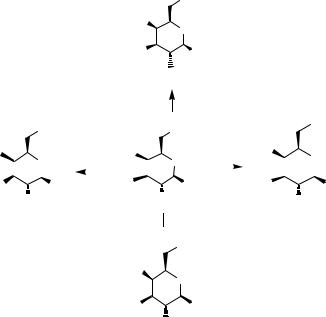
11.3 WORK FROM THE WONG LABORATORY 223
OH
LevO |
O |
|
|
PMBO |
OR |
|
|
|
OClAc |
HF-pyr, HOAc/THF (1/4) 98%
|
|
|
OTBDPS |
|
|
|
|
|
|
OTBDPS |
|
|
|
|
|
|
|
OTBDPS |
|||
|
|
|
|
|
|
|
|
|
NaHCO3 |
|
|
|
|
|
|
||||||
|
|
|
|
|
|
|
|
|
|
|
|
|
|||||||||
HO |
|
|
|
|
H NNH /AcOH |
|
|
|
|
LevO |
|
|
|
|
|
||||||
|
|
|
|
THF/MeOH LevO |
|
|
|
|
MeOH/H2O |
|
|
|
|
|
|||||||
|
|
|
|
|
2 |
2 |
|
|
|
|
|
|
|
|
|
|
|
|
|
|
|
|
|
|
O |
|
(10:1) |
|
|
|
O |
99% |
|
|
|
|
O |
||||||
|
|
|
|
|
|
|
|
|
|||||||||||||
|
|
|
|
|
|
|
|
|
|
|
|
|
|
|
|
||||||
PMBO |
|
|
|
OR |
|
|
|
PMBO |
|
|
|
OR |
|
|
|
PMBO |
|
|
|
|
OR |
|
|
|
|
|
|
|
|
|
|
|
|
|
|
|
|
||||||
|
|
|
OClAc |
|
|
|
|
|
|
|
|
|
|
|
|
|
|
|
|
|
|
|
|
|
|
|
|
|
|
|
|
OClAc |
|
|
|
|
|
|
OH |
||||
TFA, CH2Cl2, -20o C
 97%
97%
OTBDPS
LevO
O
HO |
OR |
OClAc
Scheme 11.9 Orthogonal deprotection strategy for the preparation of carbohydrate cores.
libraries of linear and branched carbohydrates (Scheme 11.9).19 The common galactose intermediate is available in five steps from thiotoluylgalactose through sequential reaction: TBDPSCl and imidazole (100%), PMB-Cl with Bu4NI (50%), chloroacetylchloride and triethylamine (52%), and levulinic acid with DCC/DMAP (83%). Glycosylation of the thioglycoside is effected with NIH/TMSOTf followed by addition of HgBr2. An example of the method used for the preparation of one of the library members is shown in Scheme 11.10.
The generality of this strategy was investigated by the preparation of a small carbohydrate library of tri-, tetra-, and pentasaccharides (Table 11.1). This protocol quickly becomes burdensome if libraries (rather than single targets) are desired since it requires isolation of every intermediate. We pursued one-pot methods as a practical and more efficient alternative. (See Scheme 11.11.)
11.3.2 Programmable One-Pot Synthesis
We use the term “programmable” to describe the rational (and ideally, computer-aided and automated) approach to polysaccharide synthesis.20 To reduce the synthesis of complex carbohydrates to routine, we envision a four-step protocol: (1) the sequence of interest is keyed into a computer, (2) the computer selects appropriate reagent combinations, (3) a laboratory worker (human or robotic) prepares the reagent
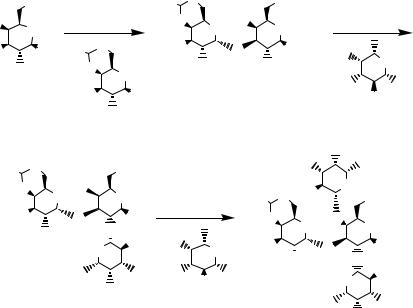
224 CARBOHYDRATE LIBRARIES IN SOLUTION
|
OTBDPS |
|
Ph O |
|
OTBDPS |
|
|
||
|
|
|
|
|
|
|
|
||
LevO |
|
DMTST |
O |
LevO |
|
|
1. NaHCO3; MeOH/H2O |
||
|
99% |
|
|
|
98% |
||||
O |
O |
|
O |
|
|
||||
|
|
|
|
|
|
|
|||
HO |
OR |
Ph |
O |
BnO |
O |
|
OR |
BnO |
|
|
|
|
|
|
|
|
|
O |
|
OClAc |
O |
|
OBn |
OClAc |
|
||||
O |
|
|
|||||||
|
|
|
|
|
|
||||
|
|
|
|
|
|
|
BnO |
STol |
|
|
|
|
|
|
|
|
|
||
|
|
BnO |
STol |
|
|
|
|
|
OBn |
|
|
|
|
|
|
|
|
|
|
|
|
|
OBn |
|
|
|
|
|
DMTST |
|
|
|
|
|
|
|
|
|
92% |
|
|
|
|
|
|
|
|
OBn |
|
Ph |
O |
|
OTBDPS |
|
|
BnO |
|
|
|
|
|
|
|
|
|
||||
O |
O |
LevO |
O |
|
Ph |
O |
BnO |
O |
OTBDPS |
|
|
|
|
||||||
|
|
|
|
|
|||||
BnO |
|
|
OR |
2. H2NNH2/AcOH |
|
|
|
|
|
|
O |
|
O |
|
O |
O |
O |
||
|
OBn |
|
O |
|
|
|
|
||
|
|
|
|
|
|
|
|
||
|
|
OBn |
BnO |
|
|
|
|
|
|
|
|
|
BnO |
|
|
O |
OR |
||
|
|
|
O |
O |
|
OBn |
|||
|
|
|
|
|
|
|
|
O |
|
|
|
|
OBn |
BnO |
STol |
|
|
O |
OBn |
|
|
|
|
OBn |
|
|
|
|
|
|
|
|
OBn |
|
|
|
|
|
|
|
|
|
DMTST |
|
|
|
|
|
|
|
|
|
|
|
|
|
|
OBn |
|
|
|
|
|
90% |
|
|
|
|
|
|
|
|
|
|
|
|
|
OBn |
|
|
|
|
|
|
|
|
|
|
|
Scheme 11.10 Application of an orthogonal protection/deprotection strategy in preparation of a tetrasaccharide.
containers for the delivery to the reaction vessel, and (4) the synthesis is executed and a crude reaction product is delivered. Subsequent purification affords the oligosaccharide of interest. Developing libraries of reagents and understanding the relative reactivities of these reagents are paramount to the success of this strategy.
11.3.2.1 Strategy Our strategy for one-pot methods rested on using common anomeric groups, and a common activator. We chose p-methylphenyl thioglycosides (STol) as our donor species for three reasons:
1.Thioglycosides can be activated by a wealth of strategies,3,4 although our investigations center on the use of electrophilic iodine (N-iodosuccinimide).
2.The thiotoluoyl group offers a convenient spectroscopic handle.
3.The reagents have significant shelf lives.
Our goals for assembly of carbohydrate libraries included (1) methods that did not rely on protecting group manipulations during synthesis and (2) the preparation of a significant pool of reagents. Additionally, we desired building blocks that afforded simple, branched carbohydrates as well. These building blocks should also allow for both α and β linkages to be prepared. To accomplish this strategy under competitive reaction (one-pot)
|
|
11.3 WORK FROM THE WONG LABORATORY |
225 |
||
TABLE 11.1 Preparation of a Carbohydrate Library |
|
|
|||
|
|
|
|
|
|
Number |
R1 |
R2 |
R3 |
R4 |
% |
1 |
L-Fuc(α1,2) |
D-Gal(α1,3) |
Lev |
TBDPS |
87 |
2 |
L-Gal(α1,2) |
D-Gal(α1,3) |
Lev |
TBDPS |
60 |
3 |
L-Gal(β1,2) |
D-Gal(α1,3) |
Lev |
TBDPS |
33 |
4 |
D-Man(α1,2) |
D-Gal(α1,3) |
Lev |
TBDPS |
78 |
5 |
L-Fuc(α1,2) |
D-Gal(α1,3) |
Lev |
TBDPS |
53 |
6 |
L-Fuc(β1,2) |
D-Gal(α1,3) |
Lev |
TBDPS |
38 |
7 |
D-GalN3(α1,2) |
D-Gal(α1,3) |
Lev |
TBDPS |
72 |
8 |
D-GalN3(β1,2) |
D-Gal(α1,3) |
Lev |
TBDPS |
14 |
9 |
L-Fuc(α1,2) |
D-GalN3(α1,3) |
Lev |
TBDPS |
29 |
10 |
L-Fuc(β1,2) |
D-GalN3(α1,3) |
Lev |
TBDPS |
5 |
11 |
D-Man(α1,2) |
D-GalN3(α1,3) |
Lev |
TBDPS |
34 |
12 |
ClAc |
D-Gal(α1,3) |
L-Fuc(α1,4) |
TBDPS |
65 |
13 |
ClAc |
D-Gal(α1,3) |
Lev |
L-Fuc(α1,6) |
59 |
14 |
ClAc |
D-Gal(α1,3) |
Lev |
L-Fuc(β1,6) |
22 |
15 |
ClAc |
D-Glc(α1,3) |
L-Fuc(α1,4) |
TBDPS |
59 |
16 |
ClAc |
D-Glc(α1,3) |
Lev |
L-Fuc(α1,6) |
67 |
17 |
ClAc |
D-Glc(α1,3) |
Lev |
L-Fuc(β1,6) |
22 |
18 |
L-Fuc(α1,2) |
D-Glc(α1,3) |
Lev |
TBDPS |
76 |
19 |
L-Fuc(α1,2) |
D-Glc(α1,3) |
Lev |
TBDPS |
13 |
20 |
L-Fuc(α1,2) |
D-Man(α1,3) |
Lev |
TBDPS |
35 |
21 |
L-Fuc(α1,2) |
PMB |
Lev |
L-Fuc(α1,6) |
57 |
22 |
L-Fuc(α1,2) |
PMB |
Lev |
L-Fuc(β1,6) |
16 |
23 |
L-Fuc(α1,2) |
PMB |
D-Glc(1,4) |
TBDPS |
65 |
24 |
L-Fuc(α1,2) |
L-Fuc(α1,3) |
Lev |
TBDPS |
85 |
25 |
ClAc |
D-Gal (α1,3) |
Lev |
D-Glc(β1,6) |
26 |
26 |
ClAc |
D-Gal (α1,3) |
Lev |
D-Glc(α1,6) |
52 |
27 |
L-Fuc(α1,2) |
PMB |
Lev |
D-Glc(α1,6) |
60 |
28 |
ClAc |
PMB |
D-Glc(1,4) |
D-Glc(1,6) |
66 |
29 |
L-Fuc(α1,2) |
D-Gal (α1,3) |
L-Fuc(α1,4) |
TBDPS |
74 |
30 |
L-Fuc(α1,2) |
D-Gal (α1,3) |
L-Fuc(α1,4) |
L-Gal(α1,6) |
45 |
31 |
L-Fuc(α1,2) |
D-Gal (α1,3) |
L-Fuc(α1,4) |
L-Gal(β1,6) |
18 |
32 |
D-Gal(α1,2) |
PMB |
D-Gal(α1,4) |
TBDPS |
76 |
33 |
ClAc |
L-Fuc(α1,3) |
D-Gal(α1,4) |
TBDPS |
54 |
34 |
ClAc |
L-Fuc(α1,3) |
D-Gal(β1,4) |
TBDPS |
14 |
35 |
L-Fuc(α1,2) |
PMB |
D-Gal(α1,4) |
TBDPS |
61 |
36 |
L-Fuc(α1,2) |
PMB |
D-Gal(β1,4) |
TBDPS |
15 |
37 |
ClAc |
PMB |
D-Gal(α1,4) |
L-Fuc(α1,6) |
37 |
38 |
ClAc |
PMB |
D-Gal(α1,4) |
L-Fuc(β1,6) |
19 |
39 |
L-Fuc(α1,2) |
PMB |
L-Fuc(α1,4) |
TBDPS |
46 |
40 |
L-Fuc(β1,2) |
PMB |
L-Fuc(α1,4) |
TBDPS |
12 |
41 |
L-Fuc(α1,2) |
PMB |
L-Fuc(β1,4) |
TBDPS |
12 |
42 |
L-Fuc(β1,2) |
PMB |
L-Fuc(β1,4) |
TBDPS |
9 |
43 |
L-Fuc(α1,2) |
D-Gal (α1,3) |
ClAc |
TBDPS |
83 |
44 |
Lev |
D-Gal (α1,3) |
D-Gal(β1,4) |
TBDPS |
46 |
45 |
Lev |
PMB |
D-Gal(β1,4) |
D-Gal(β1,6) |
49 |
|
|
|
|
|
|
conditions, we use a strategy in which the reactivity of donors decreases over the course of the reaction; that is, we intended to begin at the nonreducing end and perform glycosylations up to the reducing end. This strategy is shown schematically as applied to the synthesis of linear and simple branched targets (Scheme 11.12).
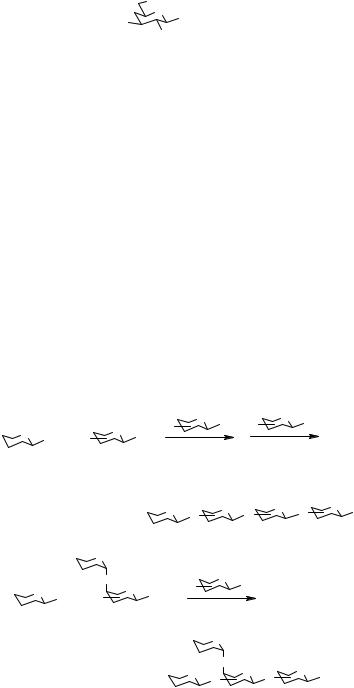
226 CARBOHYDRATE LIBRARIES IN SOLUTION
|
|
OR4 |
|
R3O |
|
O |
O(CH2)5COOMe |
|
|||
R2O |
|
|
|
|
R1O |
|
|
|
|
|
Scheme 11.11 A structure formed using a one-pot method with orthogonal protecting groups.
For this strategy to be successful, data describing the relative reactivities of a variety of donors are needed. In general, most one-pot syntheses had been carried out previously with the general knowledge of the reactivity difference between ether and ester protecting groups; where no reactivity number was involved in the design of the synthesis. We envisioned that a greater diversity of targets could be prepared if reactivity values could be collected and used. The compiled data from our group are presented in the following pages. We calculated relative reactivity values that compare the most reactive donors (high values) to the least reactive donor (1.0). Additional detail is provided in the following section.
11.3.2.2 Routes to Relative Reactivity Data Relative reactivity relationships describe the ratio of products between two glycosyl donors for an acceptor. Ley first constructed such relationships for fully protected mannoside and rhamnoside donors to rationalize the results of his one-pot syntheses employing cyclic diketals.16
Ley showed that these relationships need not be measured for every potential combination of donors, but rather the multiplicative relationship between these donors held with only small discrepancies. Throughout his work, Ley reports deactivation factors, which describe the decreased reactivity of a donor in comparison with the
|
|
|
|
HO |
O |
X |
HO |
O |
OR |
|
|
O |
|
+ |
O |
|
|
|
|
||||
|
X |
|
|
|
|
|
|
|
|||
X |
HO |
|
|
|
|
|
|
|
|||
|
|
|
|
|
|
|
|
||||
most |
|
|
less |
|
least |
|
|
|
|
|
|
reactive |
|
|
reactive |
|
reactive |
|
|
|
|
|
|
|
|
|
|
O |
O |
O |
O |
O |
O |
O |
OR |
|
|
|
|
|
|
|
|||||
|
|
|
O |
|
|
|
|
|
|
|
|
|
|
|
O |
|
HO |
O |
OR |
|
|
|
|
O |
|
|
O |
|
|
|
|
|
|
||
|
|
|
|
|
|
|
|
|
|||
|
X |
+ HO |
X |
|
|
|
|
|
|
|
|
|
|
|
|
|
|
|
|
|
|||
most |
|
less |
|
|
|
|
|
|
|
|
|
reactive |
|
reactive |
|
|
|
|
|
|
|
||
|
|
|
|
|
|
O |
|
|
|
|
|
|
|
|
|
|
|
O |
O |
|
O |
|
|
|
|
|
|
|
O |
O |
O |
OR |
|
||
|
|
|
|
|
|
|
|
|
|||
Scheme 11.12 Synthesis of linear and simple branched targets.

11.3 WORK FROM THE WONG LABORATORY 227
perbenzylated species. As such, larger numbers imply lesser reactivity. Alternatively, we normalize reactivities to the least reactive donor; hence larger numbers in our series represent greater reactivity. Nevertheless, competition experiments are used to determine these reactivity differences. Details of these experiments vary, as Ley looks at product formation using NMR, while we look at reagent consumption using HPLC.
Competition Experiments of Ley Ley examined product distributions to obtain relative reactivity values (RRVs) for both rhamnose and mannose sugars with benzyl, 3,4-cyclic diacetals, and benzoyl groups. Using a limiting amount of acceptor (1 equiv), two donors were added in excess (2 equiv each), followed by the addition of activator (NIS/TfOH, 2 equiv) (Scheme 11.13). After quenching the reaction, the product distribution was analyzed by 1H-NMR.
|
OBz |
|
|
SEt |
|
|
|
|
SEt |
OMe |
OH |
|
|
|
|
|
|
||
|
|
|
|
|
|
|
|
||
O O |
O |
+ R"O |
|
O |
+ |
R"O |
|
O |
2 equiv. NIS/TfOH |
|
|
|
|||||||
OMe |
OMe |
R'O |
RO |
|
R'O |
RO |
|
||
|
|
|
|
|
|
|
|||
Acceptor |
|
|
A |
|
|
|
B |
|
|
1 equiv. |
|
2 equiv. |
|
|
2 equiv. |
|
|||
|
|
|
|
|
|
||||
Scheme 11.13 Production distribution in a reaction with rhamnose and mannose sugars with benzyl, 3,4-cyclic diacetals, and benzoyl groups.
Ley introducted deactivation factors (DFs) to describe the effect that a protecting group had at a position on the rate of reaction. These DFs, although carbohydrate-specific, were shown to be predictive of the RRVs for these sugars as determined by direct competition experiments. For the protecting groups used, Ley observed that the extent of deactivation of a protecting group is independent of other protecting groups on the pyranose. In our studies involving larger numbers of building blocks, we found that this observation does not necessarily hold true; that is, the effect of a protecting group is not always predictive of reactivity. From these data Ley obtained the following relationships (see also Scheme 11.14).
Competition Experiments of Wong RRVs were obtained by monitoring the disappearance of donor with respect to a standard. These rates are obtained by HPLC identification of the starting materials and did not rely on identification of the product. Each donor (0.01 M, 0.01 mmol, each) was added to an excess of acceptor, methanol (0.05 M, 0.05 mmol), in dichloromethane. We use methanol as an acceptor to eliminate the steric effect on the glycosylation reaction. Activation was accomplished by adding a solution of NIS in acetonitrile (0.01 mmol) followed by TfOH (0.001 mmol) (see Scheme 11.15). After 2 h, the reaction was worked up with saturated sodium thiosulfate, then sodium bicarbonate, and the organic phases evaporated to dryness. The resulting residue was suspended and subjected to HPLC analysis. To
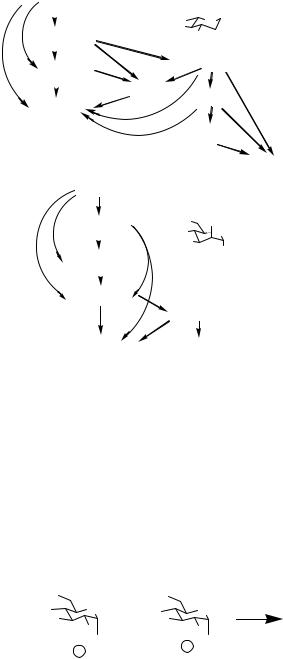
228 CARBOHYDRATE LIBRARIES IN SOLUTION
|
|
TriBn |
|
Rhamnosides |
|
|||||||
|
|
|
|
|
|
SEt |
|
|||||
|
|
|
3.1 |
|
|
|
|
|
||||
|
|
|
|
|
|
|
|
|
|
|||
|
|
|
|
HO |
O |
|
||||||
|
|
|
|
|
|
|
|
|||||
|
|
2,4-DiBn-3-Bz |
|
|
HO |
|
|
|
||||
|
|
|
|
|
|
|||||||
|
8.9 |
|
2.5 |
5.1 |
|
OH |
|
|||||
|
|
|
|
|||||||||
26.6 |
|
|
2.1 |
2-Bn-3,4-DiBz |
||||||||
|
|
|
|
|
||||||||
|
|
2,3-DiBn-4-Bz |
|
1.7 |
|
|
|
|
|
|||
|
|
|
|
2.6 |
|
|
2.8 |
|
||||
|
|
|
|
3.9 |
2-Bn-3,4-CDA |
|
|
|||||
|
|
|
|
|
||||||||
|
|
1.7 |
2.1 |
|
4-Bn-2,3-DiBz 24.2 |
|||||||
|
|
3,4-DiBn-2-Bz |
|
|
|
|
|
13 |
||||
|
|
|
|
|
|
|
|
5.3 |
|
|
|
|
1.6
3-Bn-2,4-DiBz
2.5
TriBz
TetraBn
Mannosides
1.1
2,4,6-TriBn-3-Bz |
HO |
OH |
|||||
HO |
O |
||||||
|
|
|
|
|
|||
4.6 |
|
4.5 |
HO |
SEt |
|||
|
|||||||
2,3,6-TriBn-4-Bz |
|
||||||
|
|
||||||
10.2 |
|
7.2 |
|
||||
|
|
1.7 |
|
||||
|
32.6 |
|
|||||
|
|
|
|
|
|
||
2,3,4-TriBn-6-Bz
1.7
3.22-Bn-3,4-CDA
1.2
 2.4 3,4,6-TriBn-2-Bz 2-Bn-3,4-BDA
2.4 3,4,6-TriBn-2-Bz 2-Bn-3,4-BDA
Scheme 11.14 Reactions with rhamnose and mannose sugars demonstrating relative extent of protecting group deactivation.
accommodate the wide range in relative reactivities, four reference molecules were selected as shown. From the competition experiments, the reactivity coefficients (Schemes 11.16–11.18) were tabulated.
11.3.2.3 Lessons Learned The quantification of reactivity for the 50 donors explored revealed some interesting trends, which are reported on in the following paragraphs:20
1. Pyranosides show reactivities that differ as a function of sugar. Comparison of commonly protected pyranosides (i.e., perbenzylated) showed that, in general,
|
|
R"'O |
|
|
R"'O |
|
|
MeOH |
+ |
R"O |
O |
+ |
R"O |
|
O 1 equiv. NIS/TfOH |
R'O |
|
|
|
||||
|
|
RO |
|
R'O |
RO |
||
|
|
|
|
|
|||
Acceptor |
|
|
STol |
|
|
B |
STol |
1 equiv. |
|
|
A |
|
|
|
|
|
|
|
|
|
|
||
1 equiv. |
1 equiv. |
|
Scheme 11.15 Product distribution using methanol as an acceptor to eliminate the steric effect on a glycosylation reaction.
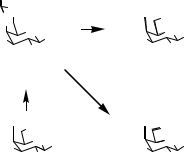
|
|
|
11.3 |
WORK FROM THE WONG LABORATORY 229 |
||
Ph |
|
|
|
|
|
|
O |
|
|
|
BzO |
OBz |
|
O |
|
|
|
50 |
|
|
BzO |
O |
STol |
BzO |
O |
STol |
|
|
|
|||||
|
OBz |
|
|
OBz |
||
(285) |
|
|
|
(5.7) |
|
|
|
|
|
|
20 |
|
|
58.1 |
|
|
|
|
|
|
BnO |
OBn |
|
AcO |
OAc |
|
|
|
|
|
|
|||
BnO |
|
O |
STol |
AcO |
O |
STol |
|
|
|
||||
|
|
OBn |
|
OAc |
||
(17000) |
|
|
(14.3) |
|
||
Scheme 11.16 Monitoring the relative reactivity values of four reference molecules.
reactivity decreases in the order fucose > galactose > glucose > mannose. These differences in reactivity are not great. Fucose is approximately four-fold more reactive than galactose which is approximately sixfold more reactive than glucose. These observations are not new, but rather are consistent with the rates of hydrolysis of their corresponding glycosyl halides and glycosides.21,22
2. 1H NMR is predictive of reactivity within a series. Within a set of common donors (i.e., galactose) in which the C2 position is constant, the 1H chemical shift of the anomeric carbon appears to be a good predictor of relative reactivity. Little correlation is found when the C2 position is varied, or between different donor pyranoses. The extent to which this correlation will prove useful remains in question. We envision that its primary applicability may be in trouble shooting a failed synthesis when a complex donor does not behave as predicted. Checking the 1H NMR of the advanced intermediate may quickly reveal that the RRV value for the pyranose of interest is not as expected, and hence the reactivity is not as expected.
3.The reactivity of aminosugars can be tuned by choice of the N-protecting group.
We investigated the ability of different N-protecting groups on glucosamine and galactosamine in order to generate donors that could be used early in a synthetic protocol (reactive) or later (less reactive). Although we were not surprised, we found that the nature of the protecting group played some role. Aminosugars bearing phthalamide groups showed very little reactivity (1.0–3.5) in comparison with those bearing Troc (trichloroethoxycarbonyl) groups (28.6). Given the large effect of the C2 group on overall reactivity of a donor, the range of reactivities, 1–28.6, is small and may greatly determine where these molecules can be incorporated into targets. Increasing these reactivities through alternate C2 groups or different protecting groups on hydroxyl groups should be investigated. Otherwise, alternate strategies may have to be employed for some targets.
4.A general trend in protecting group effects exists. For galactose, the most thoroughly explored series of donors, we find that the substituent plays a significant
